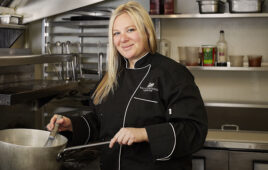An executive chef’s official role in a club or resort setting can be described in the well-penned paragraphs of a job description or a job listing.
All of the expected credentials—relevant experience, being a leader and team builder, understanding the membership dynamic, being fiscally responsible, being organized and creative—would be included for obvious reasons. As club chefs, we must excel in these categories to be successful. But there’s a lot more to what we do.
When someone thinks about becoming a chef, they don’t typically fantasize about member satisfaction, town hall meetings, capital budgets or working holidays. They want to cook and get nominated for a James Beard Award or earn a Michelin star. But club chefs have different dragons to slay.
Making a profit in food and beverage while maintaining high member satisfaction has been my dragon as the Executive Chef of Jacksonville (Fla.) Golf and Country Club for the last ten years. But I’ve done it. And I love it.
Being a club chef comes with a level of freedom and a depth of creativity that I might not necessarily have reached if I owned my own restaurant. In clubs, our menus change more frequently because our audience eats with us more frequently. It takes a different kind of passion and drive to do what we do. And ultimately our success is measured in different ways.
The economy will ebb and flow as will member age and demographics. These variables will affect member count which affects every financial decision made including salaries and your equipment budget. One year, your success is measured in low food and labor costs. The next year your success is measured in member participation and overall satisfaction with the club’s dining operation.
While we can’t change the economy and we can’t stop members from aging or changing, we are tasked with evolving alongside these changes.
What in the world does this have with cooking or creating? It probably doesn’t seem like much when you’re sitting in meetings or making spreadsheets. But as club chefs, we have the power to make food and dining at our clubs about more than that. It cannot be overstated that how you define your own personal success is as important as how it is defined by your club. If you don’t love where you work (at least most of the time) how can you be successful?
For me, success is as simple as growth and balance. (Well, simple to define anyway.) Growth is pretty straightforward: learn more and earn more. Balance is the tricky one.
Being Chefs we must balance family and personal time, kitchen and office time, teaching and learning time. We have to balance doing the work we want to be doing with the work we have to be doing. There are only so many hours in a day, so balance remains the biggest challenge for me—and probably a lot of you, too.
It seems counterintuitive as balance is at the forefront of everything we do when it comes to cooking. We balance flavors, textures, colors on the plate, our staff, even our menu pricing. When a sauce isn’t balanced, it breaks. But we all know how to bring it back, don’t we?
My hope for this blog is to connect with club chefs, share ideas, anecdotes, recipes and even some kitchen hacks.
Let’s bring back balance to our days and growth to our careers. There are so many club chefs out there with incredible skills and hobbies beyond cooking that could serve to enhance our members’ experience, inspire other club chefs, and enrich our daily lives.
So, I’m calling on you gardeners, foragers, carpenters, engineers, food stylists, photographers, writers, parents, referees, locavores, advocates and life coaches. Let’s share, grow, balance and most of all, have fun.




